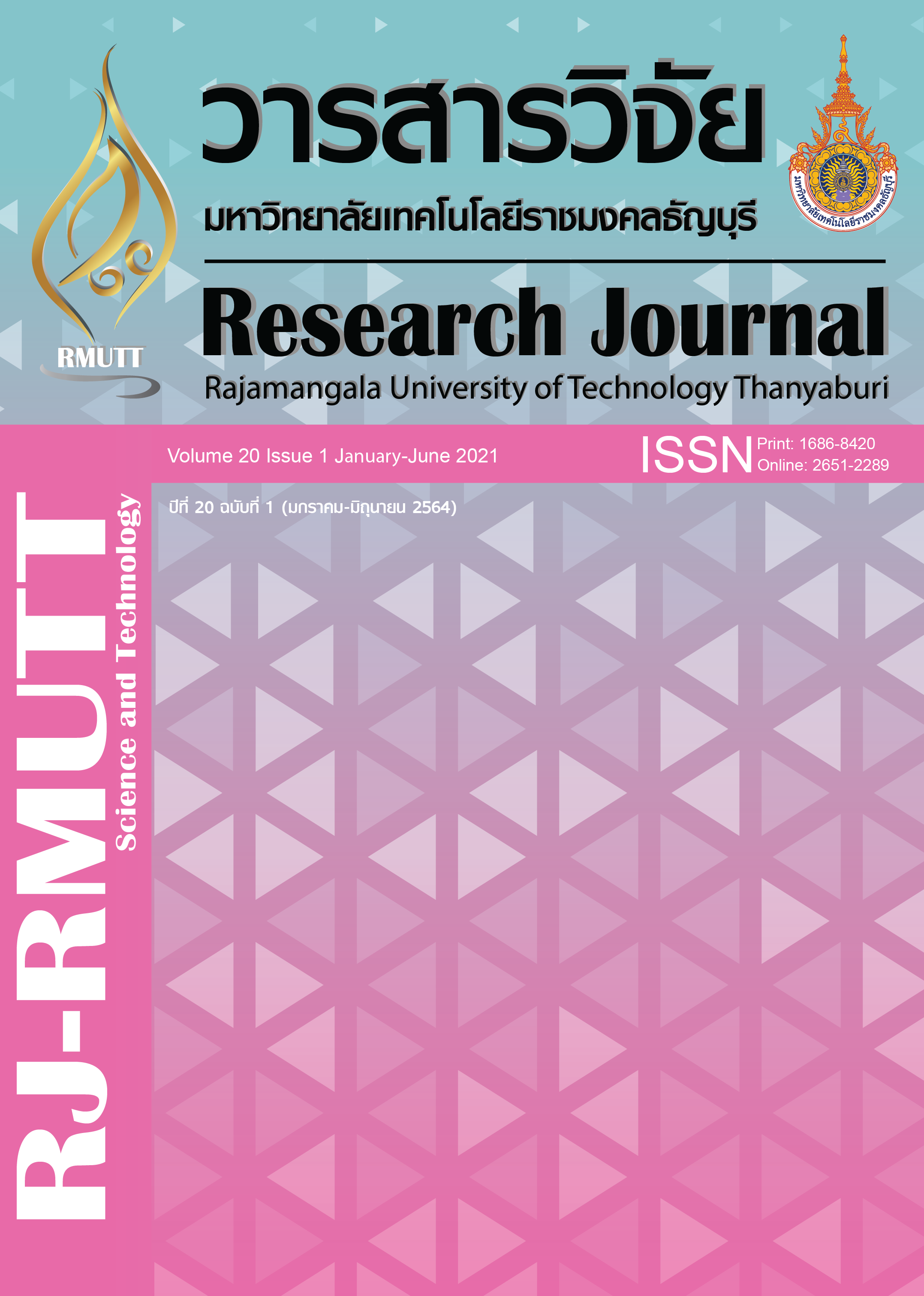A Cost-Effective and Environmentally Friendly Approach in Using Green Tea Extracts for The Determination of Iron Ion with PiCOEXPLORER
Main Article Content
Abstract
This research has been developed by using green tea extracts as a green reagent for the determination of iron ion in pharmaceutical products with PiCOEXPLORER as a detector. PiCOEXPLORER is a modern instrument based on the colorimetric system. It is a compact system and a portable device of a new generation. It is a small size colorimeter based on the RGB analysis system which allows displaying RGB intensity and absorbance for each Red (R), Green (G), and Blue (B) mode. The device is controlled by a program using an application on a smartphone with either iOS or Android operating systems. This portable device is convenient for on-site micro-scale analysis. Green tea extracts can be used as an alternative low cost and easily available reagent for the quantification of iron without purifying extraction before use. Parameters affecting the determination of iron content were optimized. Under the optimum conditions developed herein, the results showed good linearity over a Fe(III) concentration range from 2.5 to 30.0 mg×L–1 gave correlation coefficients of 0.9985 (y = 0.0093x–0.002) with a detection limit (LOD) of 0.5 mg×L–1 and quantification limit (LOQ) of 1.3 mg×L–1. The repeatability of the proposed method was less than 4 %RSD (n = 7). The proposed method was successfully applied to pharmaceutical products. The results matched well with those obtained from the standard method as compared at a 95% confidence level with the paired t-test. The proposed method is common, cost-effective, reduces the sample and reagent consumption, and is an environmentally friendly method. In addition, this device could be used as an alternative tool for spectroscopy study in terms of quantitative analysis instead of using a conventional spectrophotometer.
Article Details

This work is licensed under a Creative Commons Attribution-NonCommercial-NoDerivatives 4.0 International License.
References
Hentze MW, Muckenthaler MU, Galy B, Camaschella C. Two to tango: regulation of mammalian iron metabolism. Cell. 2010;142:24–8.
Clark SF. Iron deficiency anemia. Nutr Clin Pract. 2008;23:128–41.
Melwanki MB, Seetharamappa J, Masti SP. Spectrophotometric determination of iron(III) in ore, pharmaceutical formulations, plants material and foodstuff using piroxicam. Indian J Chem. 2003;42:576–8.
Zachariadis GA, Raidou ES, Themelis DG, Stratis JA. Determination of mineral content of active dry yeast used in pharmaceutical formulations. J Pharm Biomed. 2002;28:463–73.
Rajbhandari A, Aryal A, Rajbhandari SD. Determination of iron in iron tablets by spectrophotometry and atomic absorption spectroscopy. Int J Pharm. 2013;4(3):435–8.
Zachariadis GA, Michos CE. Development of a slurry introduction method for multi-element analysis of antibiotics by inductively coupled plasma atomic emission spectrometry using various types of spray chamber and nebulizer configurations. J Pharm Biomed. 2007;43(3): 951–8.
Mahmoud WH. Iron ion-selective electrodes for direct potentiometry and potentiotitrimetry in pharmaceuticals. Anal Chim Acta. 2001;436(2):199–206.
Merli D, Profumo A, Dossi C. An analytical method for Fe(II) and Fe(III) determination in pharmaceutical grade iron sucrose complex and sodium ferric gluconate complex. J Pharm Anal. 2012;2(6):450–3.
Khuhawar MY, Lanjwani SN. Liquid chromatographic determination of cobalt(II), copper(II) and iron(II) using 2-thiophenal-dehyde-4-phenyl-3-thiosemicarbazone as deri-vatizing reagent. Talanta. 1998;46:485–90.
Senyuva HZ, Sarica DY, Ozden T. Simultaneous determinationof Fe(II) and Fe(III) in pharmaceutical sample by post-column derivatization/HPLC. Turk J Chem. 2002;26:425–30.
Siriangkhawut W, Khanhuathon Y, Chantiratikul P, Ponhong K, Grudpan K. A green sequential injection spectrophotometric approach using natural reagent extracts from heartwood of Ceasalpinia Sappan Linn. for determination of aluminium. Anal Sci. 2016;32:329–36.
Costa AD, Sulistyarti H, Sabarudin A. Tea leaves extract as a natural reagent for quantification of copper using sequential injection analysis (SIA). ARPN J Eng Appl Sci. 2017;12(24):7274–6.
Tontrong S, Khonyoung S, Jakmunee J. Flow injection spectrophotometry using natural reagent from Morinda citrifolia root for determination of aluminium in tea. Food Chem. 2012;132(1):624–9.
Ryan P, Hynes MJ. The kinetics and mechanisms of the complex formation and antioxidant behaviour of the polyphenols EGCg and ECG with iron(III). J Inorg Biochem. 2007;101(4):585–93.
Elhabiri M, Carër C, Marmolle F, Traboulsi H. Complexation of iron(III) by catecholate-type polyphenols. Inorg Chim Acta. 2007;360:353–9.
Hynes MJ, Coinceanainn MO. The kinetics and mechanisms of the reaction of iron(III) with gallic acid, gallic acid methyl ester and catechin. J Inorg Biochem. 2001;85(2-3):131–42.
Khokhar S, Apenten RKO. Iron binding characteristics of phenolic compounds: some tentative structure–activity relations. Food Chem. 2003;81:133–40.
Settheeworrarit T, Hartwell SK, Lapanat-noppakhun S, Jakmunee J, Christian GD, Grudpan K. Exploiting guava leaf extract as an alternative natural reagent for flow injection determination of iron. Talanta. 2005;68(2):262–7.
Pinyou P, Hartwell SK, Jakmunee J, Lapanatnoppakhun S, Grudpan K. Flow injection determination of iron ions with green tea extracts as a natural chromogenic reagent. Anal Sci. 2010;26:619–23.
Saklar S, Ertas E, Ozdemir IS, Karadeniz B, Effects of different brewing conditions on catechin content and sensory acceptance in Turkish green tea infusions. J Food Sci Technol. 2015;52(10):6639–46.
Cunniff P. Iron in drugs. In: Horwitz W, editor. Official Method of Analysis of AOAC International. 18th ed. vol 1. Gaitherburg: AOAC International; 1995. p. 11.


